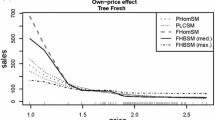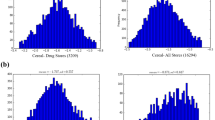Abstract
Retailing firms as a rule decide on store attributes (e.g., store size) considering an assessment of future sales of these stores. Typically, managers allocate better or more equipment to stores for which they expect higher sales. Models which ignore the fact that this behavior leads to endogeneity overestimate effects of these attributes. Managers, who base decisions on such models, loose profits by installing more (or more costly) equipment. The number of papers studying store-level sales response models accounting for endogeneity appears to be very limited. We consider potential endogeneity of store attributes in the sales response function by an instrumental variable approach. We also allow for heterogeneity across stores by assuming that store-level coefficients are generated by a finite mixture distribution. Models are estimated by a Markov chain Monte Carlo simulation technique which combines two Gibbs sampling algorithms. In the empirical study both heterogeneity and endogeneity turn out to influence estimates. For a cross section of more than 1,000 gas stations credible intervals of differences of coefficients are computed between models ignoring and models considering endogeneity. These intervals indicate that models which ignore endogeneity overestimate the effects of two store attributes on sales. We also discuss managerial implications of these endogeneity biases.
Similar content being viewed by others
References
Bound J, Jaeger DA, Baker RM (1995) Problems with instrumental variables estimation when the correlation between the instruments and the endogenous explanatory variable is weak. J Am Stat Assoc 90: 443–450
Bronnenberg BJ, Mahajan V (2001) Unobserved retailer behavior in multimarket data: joint spatial dependence in market shares and promotion variables. Mark Sci 20: 284–299
Cameron AC, Trivedi PK (2005) Microeconometrics. Cambridge University Press, Cambridge
Card D (1999) The causal effect of education on earnings. In: Ashenfelter O, Card D (eds) Handbook of labor economics, vol 3A. North-Holland, Amsterdam, pp 1801–1863
Card D (2001) Estimating the returns to schooling: progress on some persistent econometric problems. Econometrica 69: 1127–1160
Chintagunta P, Tülin E, Rossi PE, Wedel M (2006) Structural model building in marketing: review and assessment. Mark Sci 25: 604–616
Ebbes P, Wedel M, Böckenholt U (2009) Frugal IV alternatives to identify the parameter for an endogenous regressor. J Appl Econom 24: 446–468
Frühwirth-Schnatter S (2001) Markov chain Monte Carlo estimation of classical and dynamic switching and mixture models. J Am Stat Assoc 96: 194–209
Frühwirth-Schnatter S (2006) Finite mixture and Markov switching models. Springer, New York
Gelfand AE (1996) Model determination using sampling-based methods. In: Gilks WR, Richardson S, Spiegelhalter DJ (eds) Markov chain Monte Carlo in practice. Chapman & Hall, Boca Raton, pp 145–161
Gelfand AE, Dey DK (1994) Bayesian model choice: asymptotics and exact calculations. J R Stat Soc Ser B 56: 501–514
Geweke J (1992) Evaluating the accuracy of sampling-based approaches to the calculation of posterior moments. In: Bernardo J, Berger J, Dawid A, Smith A (eds) Bayesian statistics, vol 4. Clarendon Press, Oxford, pp 641–649
Geweke J (2005) Contemporary Bayesian econometrics and statistics. Wiley, Hoboken
Ghosh A, McLafferty AL (1987) Location strategies for retail and service firms. Lexington Books, Lexington
Greene WH (2003) Econometric analysis, 6th edn. Prentice Hall, Upper Saddle River
Gupta S, Zeithaml V (2006) Customer metrics and their impact on financial performance. Mark Sci 25: 718–739
Hanh J, Hausman J (2003) Weak instruments: diagnosis and cures in empirical econometrics. Am Econ Rev 93: 118–125
Hansen LP (1982) Large sample properties of generalized methods of moments estimators. Econometrica 50: 1029–1054
Hanssens DM, Parsons LJ, Schultz RL (2001) Market response models, 2nd edn. Kluwer, Boston
Hruschka H (1996) Marketing-Entscheidungen. Vahlen, München
Kao LJ, Chiu CC, Gilbride TJ, Otter T, Allenby GM (2005) Evaluating the effectiveness of marketing expenditures. Working Paper, Fisher College of Business, Ohio State University
Kass RE, Carlin BP, Gelman A, Neal RM (1998) Markov chain Monte Carlo in practice: a roundtable discussion. Am Stat 52: 93–100
Lenk PJ, DeSarbo WS (2000) Bayesian inference for finite mixtures of generalized linear models with random effects. Psychometrika 65: 93–119
Lewbel A (1997) Constructing instruments for regressions with measurement error when no additional data are available, with an application to patents and R&D. Econometrica 65: 1201–1213
Richardson S, Green PJ (1997) On Bayesian analysis of mixtures with an unknown number of components (with discussion). J R Stat Soc B 59: 731–758
Shi JQ, Murray-Smith R, Titterington M (2005) Hierarchical Gaussian process mixtures for regression. Stat Comput 15: 31–41
Stephens M (2000) Bayesian analysis of mixture models with an unknown number of components–an alternative to reversible jump methods. Ann Stat 28: 40–74
Stock JH, Wright JH, Yogo M (2002) A survey of weak instruments and weak identification in generalized method of moments. J Bus Econ Stat 20: 518–529
Tanner MA (1996) Tools for statistical inference. Methods for the exploration of posterior distributions and likelihood functions, 3rd edn. Springer, New York
Van Dijk A, Van Heerde H, Leeflang PSH, Wittink DR (2004) Similarity-based spatial methods to estimate shelf space elasticities. Quant Mark Econ 2: 257–277
Wansbeek TJ, Wedel M (1999) Marketing and econometrics: editors’ introduction. J Econom 89: 1–14
Author information
Authors and Affiliations
Corresponding author
Additional information
We thank two anonymous reviewers for their interest and comments which helped us to improve the paper.
Rights and permissions
About this article
Cite this article
Hruschka, H., Gerhardt, R.G. Endogeneity of store attributes in heterogeneous store-level sales response models. OR Spectrum 34, 199–214 (2012). https://doi.org/10.1007/s00291-009-0181-8
Published:
Issue Date:
DOI: https://doi.org/10.1007/s00291-009-0181-8




